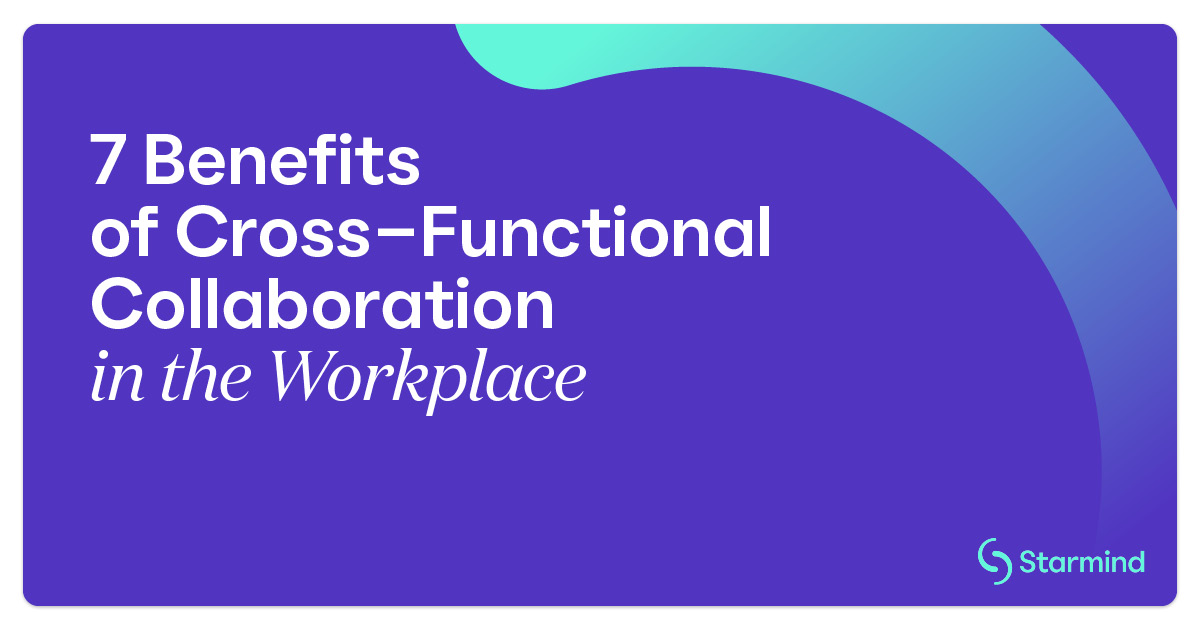Contents
As enterprise teams are increasingly distributed across the globe, effective communication and collaboration have never been more important – and more challenging. Many people only talk to their immediate team regularly, which means their knowledge gets trapped in silos.
Finding a way to break through those silos and collaborate across functions is vital for maintaining an innovative culture. Otherwise, teams end up ‘reinventing the wheel’ as they have no way to learn from their co-workers’ experiences.
In contrast, cross-functional team collaboration leverages your entire organization’s knowledge and skills to foster innovation, drive revenue and minimize wasted effort.
Let’s review how modern knowledge management can accelerate cross-collaboration in the enterprise.
What Is Cross-Functional Collaboration?
Cross-functional collaboration is when people from different areas of an organization work together to achieve shared goals. You can streamline processes and improve operational functions by pooling resources and knowledge.
For example, sales teams may need additional information for a client about a custom proposal that best fits their geographic requirements. Research and development (R&D) teams may need to understand proprietary knowledge from a previous project to inform their work. Without effective team communication, knowledge sharing and collaboration, none of these departments can promptly access the information they need.
Functional vs. Cross-Functional Teams
Functional teams are created by grouping individuals from similar functions within the organization. This structure can be naturally more efficient because team members have similar backgrounds and experiences.
Cross-functional teams include experts with different backgrounds across a range of functions. This can exponentially increase available resources, but this type of team requires additional support and communication to work effectively.
7 Benefits of Cross-Functional Collaboration in the Workplace
Cross-functional collaboration can benefit the enterprise in a variety of ways.

Sustainable Employee Engagement
Employees can feel more comfortable in their work when they know they have the resources they need to thrive. Cross-functional collaboration can provide team members with additional guidance, support, and a greater understanding of their colleagues’ work. Employee engagement naturally increases when people have opportunities to demonstrate their knowledge and abilities, contribute to shared goals and build camaraderie.
With a modern knowledge management platform, you can connect your team members to your organization’s best available knowledge in real-time. Employees can find answers quickly in the flow of work without having to waste time searching for information that may be missing or outdated. They can also raise more complicated questions or issues and quickly find subject matter experts. Support psychological safety by allowing your team members to ask and answer these questions anonymously without risk of embarrassment or concern about hierarchies.
More Agile Knowledge Management Frameworks
One of the primary benefits of cross-functional collaboration is the ability to accelerate go-to-market initiatives through shared effort. However, without a flexible plan and system, interdepartmental projects can add complexity and slow progress. Establish and embrace agile frameworks and workflows in your knowledge management system that naturally streamline processes while allowing for issues to be addressed in real-time.
Deeper Mutual Understanding of Colleagues’ Roles and Responsibilities
Effective cross-functional collaboration requires each team member to understand their roles and responsibilities. Subject matter experts can be easily identified for specific components or stages of each project. Once identified, they can easily share their knowledge with other team members.
A Faster Pace for Innovation
For enterprise R&D teams, projects often require resources beyond the scope of a single team working in a single location. A modern knowledge management platform can help these remote teams easily share information and discoveries, all while reducing duplicative work.
Enhanced Continuity of Organizational Knowledge
Cross-functional collaboration offers a unique opportunity to build enhanced organizational knowledge by collecting and organizing contributions from team members across business units.
Streamlined Work Processes
When business functions effectively work together, they can condense overlapping responsibilities and more easily share knowledge and resources. With a modern knowledge management system, you can capture and share knowledge in the flow of work.
Stronger Communication and Teamwork
Cross-collaboration empowers team members to recognize their peers’ value as they showcase their own knowledge and skills. When operating solely within their department or function, team members may have limited insight into knowledge sharing. Cross-collaborating teams, by contrast, can assign their most capable employees to the toughest challenges, regardless of their position within the organization.
8 Best Practices for Effective Cross-Functional Collaboration in the Enterprise
Consider these best practices for collaborating across organizational functions.

Develop a Modern Collaboration Framework
Develop a collaboration framework with a core foundation that includes your mission, vision and values. Expand that framework to include the project descriptions, goals, challenges and other important factors. This framework should also serve as a reference for evaluating progress and measuring success.
Encourage Transparency
Promote transparency by establishing formal systems for two-way communication across your organization. Keep team members informed of key developments and challenges, and provide opportunities for them to provide feedback.
Get Clear With Primary Goals
Effective cross-functional teams require a common vision to unite them. While any particular project could benefit each team in different ways, the bigger picture should include overarching primary goals. These goals should encompass each functional area and drive a unified effort throughout the collaboration.
Teams can understand goals better when they have clear project timelines that include checkpoints at key stages. This should be tracked so that project leaders can measure and analyze results.
Clarify Everyone’s Roles
Clarity on goals is an important step, but projects can still fail when teams don’t understand their assignments or when there’s conflict over roles and responsibilities. Defining these aspects should be a prerequisite for projects involving cross-functional collaboration. Each team member should know their role in the project and where — or who — they should turn to for issues or support.
Focus on Diversity
Diversity is at the heart of cross-functional collaboration. Projects should include groups and individuals from different backgrounds and knowledge areas. This diversity will yield unique perspectives and unlock knowledge that would otherwise be siloed or ignored.
Avoid Micromanagement
Cross-functional collaboration helps you identify your strongest performing team members and let them put their knowledge and abilities to work. Provide your team with the resources they need to complete their work and a clear path to ask for assistance. When you discourage micromanagement, you save time and help your team members feel respected and appreciated.
Build Team Identity
Cross-functional collaboration is a team sport, but everyone on the team is also part of other teams throughout your organization. Help them work toward a shared vision and align on purpose and values. Even as teams work as a unit, they should identify and use the strengths of individuals to elevate the group’s performance.
Embrace the Power of Automation
Manual work is time-consuming, expensive and more likely to contain errors. Embrace work automation to streamline processes and augment human intelligence, saving your team time to focus on business-critical tasks. This includes your knowledge management processes, as projects will go faster and more smoothly when employees can access reliable information in real-time from a trusted central source.



